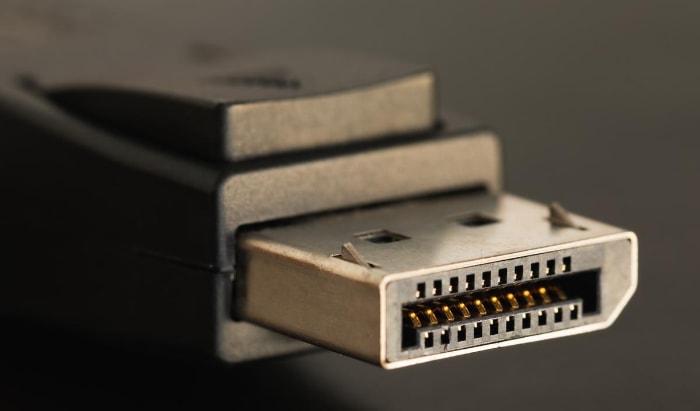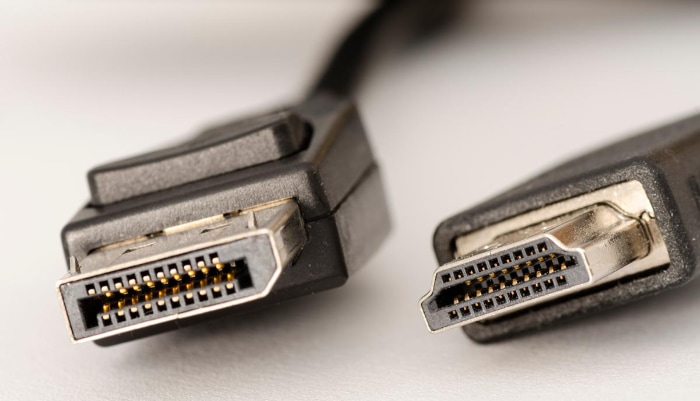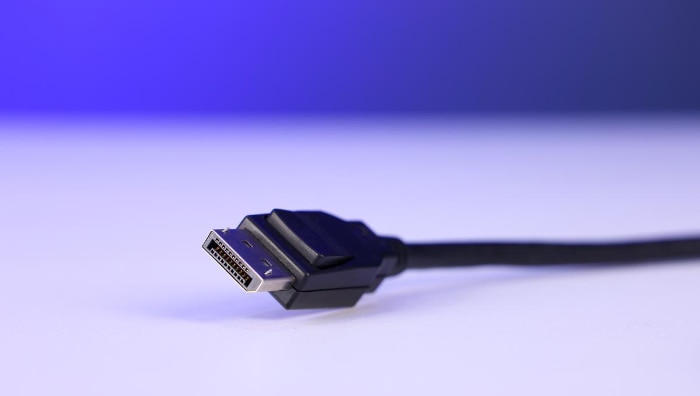Does DisplayPort Carry Audio? Exploring Features

DisplayPort has increasingly become a fixture in modern computing and home entertainment setups, and for good reason. Offering high-definition video and a host of other features, it’s a powerful tool in the transmission of visual data.
But what about audio? If you’ve found yourself wondering, “Does DisplayPort carry audio as well?” you’re not alone. The answer, in short, is yes. DisplayPort is fully equipped to carry audio signals alongside video, making it a robust solution for your multimedia needs.
Technical Specifications of DisplayPort
Understanding the technical specifications of DisplayPort provides a comprehensive view of its capabilities, including its ability to transmit both video and audio. Here we break down the architecture, version variations, and audio-visual specifications that have cemented DisplayPort as a go-to interface for multimedia transmission.
DisplayPort Architecture
The architecture of DisplayPort involves a high-speed serial link that uses a Main Link, an Auxiliary Channel, and a Hot Plug Detect mechanism. The Main Link carries the actual video and audio data, while the Auxiliary Channel is used for control and configuration, and the Hot Plug Detect mechanism signals the connection status.
Version Variations and Their Impact on Audio
DisplayPort has undergone several revisions, with each subsequent version introducing data rate, resolution, and audio features improvements. Here are the versions most commonly encountered:
- DisplayPort 1.1 – Supports 8 channels of audio and a maximum bandwidth of 8.64 Gbps.
- DisplayPort 1.2 – Increased bandwidth to 17.28 Gbps and added support for 3D video formats.
- DisplayPort 1.3/1.4 – Bandwidth increased further to 25.92 Gbps and 32.4 Gbps, respectively, with enhanced audio formats like Dolby Atmos included.
- DisplayPort 2.0 – The latest version as of now, offering a whopping 77.4 Gbps bandwidth and supporting even more complex audio setups.
Audio Signal Transmission
DisplayPort is designed to carry audio signals in a digital format. This means that the audio stream is embedded within the Main Link, traveling alongside the video data.
DisplayPort supports a wide range of audio formats, including uncompressed PCM audio, compressed audio (DTS, Dolby, etc.), and up to 8 channels with 24-bit 192 kHz audio.
Audio Encoding and Synchronization
When audio is transmitted over DisplayPort, it is packetized and then serialized before being sent through the Main Link. To keep audio and video in sync, DisplayPort employs a timestamp method.
This guarantees that the audio matches the video output, preventing any issues with lip sync or sound delays issues.
Audio Channels and Bit Depth
DisplayPort can handle a multitude of audio channels and a high bit depth, making it suitable for professional audio applications. It supports audio with up to 8 channels and a bit depth of 24 bits, providing the capacity for high-definition audio output.
By comprehending these technical specifications, it becomes clear that DisplayPort is not just a video interface but a comprehensive solution for audio-visual connectivity. Its design allows for high-quality, synchronized audio transmission, positioning it as an optimal choice for both consumer and professional applications.
Audio Transmission Over DisplayPort: How it Works
The question of how DisplayPort transmits audio along with video is an intriguing aspect of this versatile technology.
The Journey of Audio Signals
Once audio data is prepared for transmission, it embarks on a journey through DisplayPort’s Main Link. The audio is packetized into smaller data units known as micro-packets, which are then transmitted along with video data.
This enables a synchronized multimedia experience that is visually rich and sonically coherent.
Encoding Methods
The audio transmitted via DisplayPort is typically in digital format, which can be either compressed or uncompressed. Formats such as PCM (Pulse-Code Modulation) provide uncompressed audio, while technologies like DTS or Dolby encode audio in a compressed form.
Both forms have their merits, with uncompressed audio providing the highest quality at the cost of increased bandwidth usage.
Synchronization Mechanisms
Ensuring that audio and video are in perfect harmony is critical for an immersive experience. DisplayPort employs timestamp methods that align the audio frames with video frames.
This way, both the audio and video signals reach the output device at the same time, eliminating issues like lip sync delays.
Audio Channels and Configuration
DisplayPort supports multiple audio channels, allowing for complex audio setups. From basic stereo setups to elaborate 7.1 surround sound systems, DisplayPort has the bandwidth and configuration options to handle it all.
It can also carry high-definition audio formats like Dolby TrueHD, adding an extra layer of sophistication to your audio experience.
Support for High Bit Rate Audio
With a focus on high-quality audio, DisplayPort allows for high bit rates that can exceed the capabilities of other interfaces. This results in detailed and rich audio output, making it ideal for applications that demand pristine sound quality, such as high-definition movies or professional audio editing.
Understanding the mechanisms behind audio transmission over DisplayPort gives us a well-rounded view of its capabilities. The technology has been meticulously designed to provide not just visually stunning outputs, but also audio that meets the highest standards of clarity and synchronization.
Comparison with Other Interfaces

When it comes to selecting an interface for audio-visual transmission, consumers and professionals alike have multiple options to consider.
DisplayPort vs HDMI
HDMI (High-Definition Multimedia Interface) is one of the most ubiquitous connectors, commonly found in TVs, monitors, and laptops. Like DisplayPort, it is capable of transmitting both video and audio.
However, there are distinctions in bandwidth, audio formats supported, and the number of audio channels.
- Bandwidth: DisplayPort generally offers higher bandwidth, especially in its later versions, which allows for higher resolutions and frame rates.
- Audio Formats: Both support a wide range of audio formats, but DisplayPort’s capability to support high bit rates gives it an edge in professional settings.
- Audio Channels: While HDMI supports up to 32 audio channels, DisplayPort also offers substantial support with up to 8 channels of digital audio.
DisplayPort vs VGA
VGA (Video Graphics Array) is an older interface that is steadily becoming obsolete but is still found in some legacy systems. It is worth noting that VGA does not natively support audio transmission; it is a video-only interface.
- Quality: VGA is an analog interface, which means it is prone to signal degradation, unlike DisplayPort’s digital signal.
- Audio: As VGA cannot transmit audio, users must rely on separate audio cables, complicating the setup.
DisplayPort vs DVI
DVI (Digital Visual Interface) is another digital video interface but is less commonly used today. DVI does not natively carry audio signals.
- Resolution: Both DisplayPort and DVI offer high-definition video, but DisplayPort supports higher resolutions.
- Audio: Separate cables are required for audio transmission in a DVI setup, whereas DisplayPort can carry audio and video on the same cable.
Commonality and Compatibility
Given the varying capabilities of these interfaces, compatibility becomes an essential factor. Adapters are available to convert signals between these different interfaces, but these may come with limitations such as reduced quality or the lack of audio transmission in some cases.
By examining these comparisons, it becomes evident that DisplayPort offers advantages in audio transmission, compatibility, and quality. Its design and technical specifications make it a strong contender in the realm of audio-visual interfaces, capable of meeting both consumer and professional needs.
Common Scenarios and Use-Cases
The versatility of DisplayPort in handling both audio and video signals makes it applicable in various scenarios and use-cases. From simple home entertainment setups to complex professional environments, DisplayPort’s multifaceted capabilities have proven to be invaluable.
Home Entertainment Systems
For home theater aficionados, DisplayPort serves as a reliable interface for connecting gaming consoles, Blu-ray players, and streaming devices to high-definition TVs or monitors.
- Quality: High bit rate audio can be seamlessly transmitted, making it ideal for surround sound setups.
- Ease of Use: With a single cable handling both audio and video, setup complexity is minimized.
Professional Audio and Video Editing
In studios where high-quality audio is a requisite, DisplayPort excels by offering high bit rates and multiple audio channels.
- Precision: Synchronized audio and video allow for accurate editing.
- High-Definition Audio: The support for advanced audio formats enables nuanced sound editing.
Business Presentations and Conferences
In a corporate environment, DisplayPort finds its utility in connecting laptops to projectors or large display panels for presentations.
- Clarity: High-quality audio and video ensure that presentations are clear and professional.
- Interoperability: Compatibility with various display types makes it a flexible choice for diverse conference room setups.
Educational Settings
Classrooms and educational institutions often use DisplayPort for connecting PCs to projectors or interactive whiteboards.
- Multimedia Learning: Both audio and video can be projected without the need for multiple cables, simplifying the arrangement.
- Compatibility: It can work well with various devices, making it a versatile choice for educational tech ecosystems.
Multi-Monitor Workstations
DisplayPort’s daisy-chaining capability is particularly useful for power users who use multiple monitors in a single workstation setup.
- Consistency: Uniform audio and video quality across all displays.
- Cable Management: Reduced clutter as fewer cables are needed for both audio and video signals.
In summary, the capability of DisplayPort to handle both high-quality audio and video makes it a preferred choice in a wide array of applications. Whether you’re aiming for the ultimate home theater experience or a seamless professional workflow, DisplayPort has the features and flexibility to meet a variety of needs.
Troubleshooting Tips

While DisplayPort is designed for robust performance and reliability, users may occasionally face issues related to audio transmission. Understanding how to troubleshoot these problems can help ensure that your audio-visual experience remains uninterrupted.
No Audio Output
If you find that the video is transmitting well but there is no audio output, there are a few potential fixes to consider.
- Source Device Settings: Ensure that the source device’s audio settings are configured to output audio via DisplayPort.
- Cable Inspection: Damaged or low-quality cables can result in poor or no audio. Make sure to use a certified DisplayPort cable.
Crackling or Distorted Audio
Sometimes the audio might not be clear and could be accompanied by crackling noises.
- Audio Format: Incorrect audio format settings can cause this. Ensure that the audio format on your source device matches what your output device can handle.
- Bandwidth Limitation: Lower the resolution or frame rate to see if the issue persists. Overloading the bandwidth could affect audio quality.
Limited Audio Channels
If you’re unable to access multiple audio channels or are stuck with stereo output, several factors could be at play.
- Audio Configuration: Ensure that your output device is capable of handling multiple channels and that the settings on your source device reflect this.
- Driver Update: Keeping the audio drivers updated can sometimes resolve compatibility issues.
Absence of High-Definition Audio
The absence of high-definition audio can be disappointing, especially when your setup and media are designed for it.
- Advanced Audio Settings: Navigate to the advanced settings of your audio control panel and ensure that high-definition audio is enabled.
- Media Player Settings: Some media players have their own audio settings. Make sure they are configured to use high-definition audio.
Equipped with these troubleshooting tips, you will be better prepared to resolve common issues related to DisplayPort’s audio capabilities. By understanding the root causes and knowing how to address them, you can maintain an optimal audio-visual experience.
Conclusion
DisplayPort’s ability to transmit high-quality audio and video makes it a versatile choice for many applications, from home entertainment systems to professional editing suites. We’ve delved into the technical specifications that enable seamless audio transmission, compared its capabilities with other interfaces, and even outlined common scenarios where it shines.
Finally, with the troubleshooting tips offered, you’re now equipped to handle any issues that may arise. All of these elements come together to paint a comprehensive picture of DisplayPort’s impressive audio capabilities, highlighting its utility and flexibility in modern multimedia setups.


